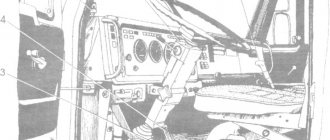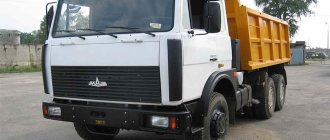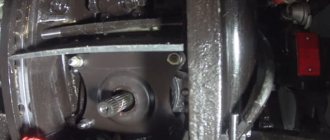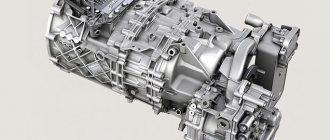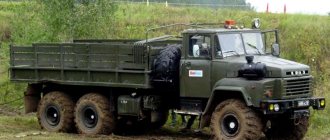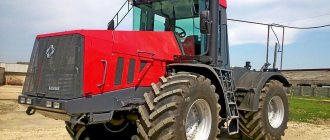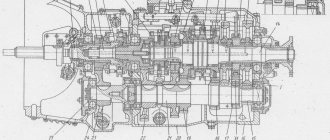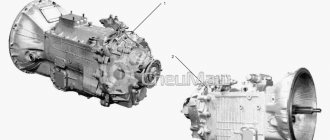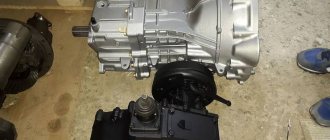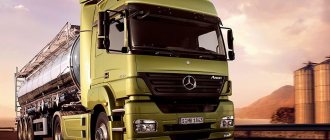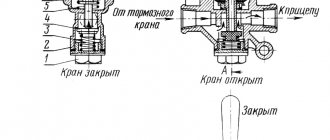Category: KAMAZ
- Description of the boxes used
- Principle of operation
- Start
- Gear shift diagram
- Box KamAZ 15
- Box KamAZ 16 and ZF
- Management Tips
- Hill climb control
- Descent Control
- Driving on an icy road
- Is it possible to drive a KamAZ without urea?
At first glance, driving a KamAZ is similar to driving a car. The principle of operation is the same as on classic transport, however, some features cause complications for the uninitiated user.
You get a complete understanding of how to properly drive and drive a KamAZ by understanding the specifics of gear shifting. The fact is that for every heavy car you need to find an approach to the issue of manipulating the gearbox, and KamAZ is no exception. In order to achieve the required speed limit when transporting cargo, the KamAZ transmission is often operated in a low gear. The acquired skills, knowledge and experience in working with the gearbox are the key to the success of further operation of the vehicle.
KamAZ-6520, dump truck:
Description of the boxes used
The gear shift pattern directly depends on the type of transmission installed on the KamAZ vehicle. Most of the machines used use a box with five forward speeds and one reverse; this is a model with index 14. The mechanism is relevant if there is no need to tow a trailer, or the cargo being transported weighs less than 10 tons.
KamAZ-14 gearbox:
Equipment used for transporting large loads, or participating in road trains, uses a transmission marked 15. In this case, you need to know how to drive a KamAZ dump truck, since the gearbox includes a gearbox. This is the same 14 transmission with five forward and one reverse gears. The divider, if necessary, includes lower speed ranges, as a result, the car has twice as many gears.
KamAZ-ZF gearbox:
The gearbox used is index 16, with eight mechanical speeds. A four-stage gearbox and a low gear are provided. ZF gearboxes are also installed, which are equipped with nine gears and an auxiliary reduction stage.
Regardless of the transmission model, the gearbox is of a mechanical type, control is carried out using the clutch pedal. The switching takes place in stages, taking into account the lower and higher modes. The lever on the rocker handle is responsible for switching modes. When creating, it was taken into account that KamAZ is a heavy vehicle, which when loaded requires a reduction in force. Conversely, if you drive with an empty body, this will not lead to overheating and fuel consumption.
What is the structure of the checkpoint
Basically, two types of gearboxes are installed on KamAZ: 5-speed (model 14) and 10-speed (model 15). The first type is installed on single Kamaz vehicles, and the second type box is more suitable for use in road trains. In addition, the 10-speed consists of a regular 5-speed. Plus, equipped with a reducer-divider. The structure of the divider gearbox allows (of course, in combination with a 5-speed gearbox) to control ten forward gears and two reverse gears.
Advantages of boxes equipped with a divider:
Mechanical gearbox
- Switching frequency decreases.
- Increasing vehicle traction.
- Easier control.
For Kamaz vehicles with heavy load capacity, the previous boxes were modernized. And a new model of gearbox 152 was released. How is it different?
- Synchronizers have been strengthened.
- New gear mounts were used.
- 4 degrees were introduced into the system to thin the teeth. This allows you to avoid “knocking out” fourth and fifth gears.
- The splines are reinforced.
- Improved divider control circuit.
- The spline mount has been removed.
- The height of the teeth has been increased.
In the new model, the divider is controlled by a pneumatic system. Only a professional and a service station employee can service such a system. Since this procedure requires certain skills and knowledge.
Principle of operation
KamAZ vehicles are usually equipped with manual transmissions. The mechanism is controlled in the classic way, by pressing the clutch pedal and moving the rocker to the required position. A special feature of the transmission is low (H) and high (B) operating modes. This ability minimizes the load on the power unit. It is typical that for this purpose a divider is used, which acts as a gearbox that increases transmission ratios. On some cars, when changing from a higher gear to a lower gear, they do not use the rocker. For these purposes, a special switch and clutch pedal are used. The gear switches automatically, the upper position of the lever is typical for a loaded vehicle, the lower position is used when moving an empty vehicle. The features of driving a car are indicated in the instructions for the gearbox that comes with the product. You can also read about How to adjust the clutch on a KamAZ.
Rules for shifting gearboxes in different conditions
Knowing how to start and how to continue moving is not enough for the correct operation of the KAMAZ transmission. To avoid problems with the unit when using the gearbox, you must follow the rules. Errors made during operation can lead to serious malfunctions.
On the rise
How to change gears on a KamAZ when driving uphill
Driving a domestic truck when lifting must be done at increased speed. To switch from first to second speed, the driver needs to depress the clutch twice. Consider the fact that you must simultaneously press the gas pedal and the fuel pedal. These actions are important as they help stabilize the overall performance of the crankshaft. To avoid problems with the operation of the unit, you do not need to reduce the engine speed to less than two thousand when climbing. This will cause the car engine to turn off. Also, such driving increases the operating temperature of the power unit, and this can cause its breakdown.
Start
To know how to properly drive a KamAZ dump truck, you need to understand the gear shift pattern. As in the standard version, manipulations take place using the clutch pedal.
Switching stages:
- 1st gear, high mode (B);
- 2nd gear, high mode (B);
- 3rd gear, high mode (B);
- Transition to the 2nd low (H) stage and switch to 4th gear;
- Transition to the primary stage (B), the gear remains in 4th;
- Shift to a lower gear (H), engage 5th gear;
- Return to the higher gear (B), stay in 5th gear.
KamAZ:
The main feature of starting to move on a KamAZ is a smooth start and acceleration using lower gears. In the case when the dump truck is heavily loaded, or the traffic is in difficult conditions, it is advisable to switch the first 4 gears in low mode (H), then switch to 4th high gear, then lower 5th gear (H) and then to 5th -th increased (B). Manipulations are carried out when the required crankshaft speed is reached. Directly at the start in 1st gear, the shaft speed reaches 7000 min-1, the transition to 2nd gear is made when the speed reaches 3000 min-1. The correctly selected mode saves fuel and minimally wears out the power plant.
Using a dump truck
Despite the fact that the KAMAZ 5320 has been out of production for more than fifteen years, these vehicles are still very popular and in demand in a variety of industries, not only in logistics, but also in agriculture, mining, construction and public utilities. This happened due to their reliability, unpretentiousness, availability of the entire range of spare parts and, most importantly, the economic feasibility of using this particular model.
Kamaz 5320 with trailer
Fuel consumption
KAMAZ 5320 with a standard trailer can transport 16 tons of cargo on any roads, including country roads in the Russian outback or in the Far North, while the fuel consumption of KAMAZ 5320 is no more than 35 liters per 100 kilometers. It’s not for nothing that this particular vehicle has become a real legend, remember the slogan - “Tanks are not afraid of dirt!” – this is about KAMAZ 5320.
Dimensions of the onboard version
Main technical characteristics for the KAMAZ 5320 truck, onboard basic version:
- Length - 739 centimeters
- Width - 250 centimeters
- Height - 283 centimeters
- Rear trolley base - 132 centimeters
- Front wheel track - 201cm
- Rear wheel track - 185 centimeters
- Lowest ground clearance - 34.5 centimeters
- Loading height - 137 centimeters
- Curb weight - 7500 kilograms
- Load capacity - 8000 kilograms
- Maximum towed trailer weight - 8000 kilograms
- Maximum gross weight - 15,305 kilograms
- Maximum speed, km/h - 85
- Braking distance for a road train with a full load from a speed of 40 km/h, meters - 21
Box KamAZ 15
This transmission is installed on KamAZ-55111, KamAZ-43118 and other models. To accelerate the car to the required speed, the following scheme is used: 1B-2B-3B-4N-4B-5N-5B. This scheme allows the box to operate normally, provided that the rules for operating the mechanism are followed:
- Using a special switch lever, change the operating mode of the box from high to low and vice versa;
- Press the clutch pedal;
- We change gears in order using the rocker.
KamAZ switching diagram:
content .. 111 112 113 114 115 116 117 118 ..
FEATURES OF DRIVING KAMAZ VEHICLES
When driving a car correctly, the average speed increases, fuel consumption decreases, the efficiency of using the vehicle (road train) and its service life increases
Warm up the engine before driving.
Start driving only after the sound indicator (buzzer) stops working and the warning lights go out, which indicates that the brake systems are filled with air.
When starting off with a loaded vehicle, engage first gear.
Shift gears smoothly and be sure to disengage the clutch; it is recommended to briefly hold the lever in the neutral position. Feeling resistance to movement
lever, do not engage the gear with sudden jerks. It is necessary to gradually increase the pressure on the lever until the synchronizer is fully engaged. If you cannot engage the gear when starting from a stop, disengage the clutch a second time and engage the gear again.
The following order of gear shifting when accelerating a vehicle is recommended:
on paved roads……………………..1В-2В-3В-4Н-4В-5Н-5В
in difficult road conditions……………………….1Н-2Н-3Н-4Н-4В-5Н-5В
When choosing the moment to shift gears, monitor the crankshaft speed using the tachometer.
Below are recommendations for choosing the crankshaft speed for changing gears when accelerating a car. Following these recommendations will ensure that the engine operates in the most economical mode.
1. In difficult road conditions or when driving on an incline, before shifting from lower (first and second) gears, it is recommended to increase the engine speed to 2600 rpm. After switching, the rotation speed must be at least 1800 rpm.
2. When driving a car on a horizontal section of a road with good coverage, you should increase the engine speed in intermediate gears to no more than 2300 rpm.
3. When driving the vehicle in conditions of low road resistance (driving downhill on a road with good surface), the maximum crankshaft speed in all gears should not exceed 2000 rpm.
4. When driving on highways, be sure to use the highest gear. It must be remembered that driving at a crankshaft speed of more than 2200 rpm (which in a 5 V gear corresponds to a car speed of 70 km/h) is uneconomical.
After coasting (by inertia, with the gear off), press the fuel pedal to equalize the angular velocities of the drive and driven shafts of the gearbox, then engage the desired gear.
You should switch to a lower gear in advance, avoiding overloading the engine.
When switching from higher gears to lower ones, the clutch should be released twice with a short press on the fuel pedal. When switching from second gear to first, this shift method is required.
Reverse gear should only be engaged after the vehicle has come to a complete stop.
When driving, do not constantly keep your foot on the clutch pedal.
Overloading a vehicle leads to premature failure of tires, steering mechanisms, and transmission parts, increases fuel consumption and makes driving more difficult. The total weight of the vehicle and road train must not exceed the established standards.
When maneuvering, it is necessary to take into account that during turns the trailer of the road train moves towards the center of the turn. When driving with a trailer (semi-trailer), you should pay special attention to wobbling, twitching, slipping and other signs of wear on the fifth-wheel and towbar parts.
The movement of the road train must be uniform, without sudden braking or jerking. It is recommended to brake the car smoothly, without allowing the wheels to slip, as this leads to increased wear of the tread and increases the braking distance of the car.
With a significant decrease in air pressure in circuit III of the pneumatic drive of the brake mechanisms (less than 540 kPa (5.5 kgf/cm2)), the car automatically brakes. If this happens in places that do not allow stopping (intersection, railway crossing), press the “Emergency brake release” button and, without releasing it, drive the car out of the danger zone at low speed.
It is not recommended to stop the road train on an ascent or descent. In the event of a forced stop, to prevent the road train from rolling away, you must engage the parking brake system and place wheel chocks under the rear wheels of the vehicle and trailer.
If any malfunctions occur that threaten traffic safety, the hazard warning system must be immediately turned on and the vehicle must be stopped to eliminate the malfunctions.
When driving on slopes, certain rules must be followed. Short climbs on good roads should be overcome using the reserve speed. When overcoming steep and protracted inclines, the gears of the divider and gearbox must be selected taking into account the vehicle load, the length and steepness of the incline, without allowing an excessive reduction in the engine crankshaft speed (the tachometer needle should be in the “green field” of the scale). If possible, you should use a gear that will ensure movement without additional switching and stopping.
When coasting downhill, it is strictly forbidden to turn off the engine, since the power steering and the compressor of the pneumatic drive of the vehicle's brake systems do not work.
To slow down when going downhill, use the auxiliary braking system, applying the brakes if necessary. When the auxiliary brake system is on, do not turn off the clutch or change gears.
When driving on slippery and icy roads, you should brake with a spare or auxiliary brake system; in this case, the brake mechanisms of the trailer (semi-trailer) are activated first. In exceptional cases and to completely stop the road train, it is permissible to brake with the service brake system when the clutch is engaged. When braking, do not allow the wheels to slip.
In the event of a skid, you must not disengage the clutch; you must gradually reduce the fuel supply and turn the steering wheel in the direction of the skid.
Changing gears and disengaging the clutch on a slippery road is not advisable.
Before moving away on a slippery section of the road, you need to lock the center differential with a lever located on the instrument panel. In this case, the warning light comes on and stays on as long as the differential is locked. After passing a slippery section of the road, you should press the clutch pedal all the way and immediately unlock the differential.
If the car stalls, you need to brake the car, lock the differential, engage second gear and, at the lowest engine speed (such that the engine does not stop), smoothly release the clutch pedal.
You cannot lock the differential when the wheels are slipping.
Cars can use snow chains. they are put on the outer wheels of the vehicle's drive axles on both sides. For easy installation of chains, there are windows in the wheel spacer rings.
When driving along a rut, you cannot keep the steering wheel turned all the way to the extreme position for more than 15 seconds (to move the steered wheels out of the rut).
When driving in fog, rain, snow, as well as when driving on narrow roads with frequent sharp turns, it is recommended to use fog lights that are turned on by a key to improve visibility.
If the power steering fails, you can only use the steering mechanism for a short time.
Long-term operation of a vehicle with an inoperative hydraulic booster is strictly prohibited.
If the power steering pump hoses rupture, do the following:
— connect the high and low pressure pipes coming from the pump with a hose and, if possible, turn on the radiator to cool the oil;
— close the injection and drain holes of the hydraulic booster;
— add oil to the pump reservoir to the level of the indicator (temporary use of engine oil is allowed, followed by replacing it as soon as possible);
— when driving the car, maintain the engine operating mode with the crankshaft rotation speed as low as possible and monitor the oil temperature in the tank; When the oil temperature is above 100 °C, stop and let the oil cool.
content .. 111 112 113 114 115 116 117 118 ..
Box KamAZ 16 and ZF
This type of transmission is used on KamAZ-65115 vehicles, as well as all-wheel drive KamAZ-43150 KamAZ-4310 and others. The peculiarity of the mechanism is the automatic switching of high and low modes. This means that when shifting from gear 4 to gear 5, the upshift mode is automatically activated. Conversely, shifting from gear 5 to gear 4 automatically activates the reduced mode. The switch is indicated by an indicator on the instrument panel.
Switching diagram ZF 9S109:
Some models of ZF gearboxes, for example, 9S109, with auxiliary gear “C”. The mode is designed for movement and maneuver in difficult conditions (snow, ice, mud).
The design of the KAMAZ-4310 chassis
KAMAZ-4310 has 6x6 all-wheel drive. Its transmission consists of a manual gearbox and transfer case. The front and rear axles of KAMAZ-4310 are equipped with differential locks. The KAMAZ-4310 transfer case is used to distribute torque between the vehicle’s axles. The KAMAZ-4310 transfer case is controlled remotely using an electro-pneumatic drive.
The truck has four driveshafts: one goes to the front axle, one to the rear axle, one to the intermediate axle and one to the middle axle. The wheels of the all-terrain vehicle have traditional wide-profile “toothy” tires. All wheels are connected to an automatic pressure control system.
The truck's brake system is drum. The drive is double-circuit pneumatic. The parking brake is also of a pneumatic type. The spare brake in the car is combined with the parking brake, and the auxiliary brake is designed as a motor retarder. It also has a pneumatic drive.
The standard military flatbed truck KAMAZ-4310 has the following features:
- There are extension lattice sides;
- The body has side and middle benches that allow you to transport up to 30 people;
- The KAMAZ-4310 cabin has three seats and is equipped with an independent heater.
Compared to other trucks of those years, KAMAZ-4310 had good cabin sound insulation. In addition, the driver's seat can be adjusted in several positions. There is no sleeping place in the KAMAZ-4310, but in more modern versions it was possible to order it as an option at the factory.
Hill climb control
Driving up a slope is accompanied by the gearbox switching to a lower mode (H). This makes the transmission work harder and overcome obstacles more easily.
- When lifting heavy equipment, shifting from first to second gear is carried out using the double clutch method;
- To ensure the operation of the power plant, depress the gas pedal to prevent an interruption in the fuel supply;
- The crankshaft speed readings do not fall below 2000 min-1, otherwise the power plant will overheat and stop working.
Shifts when overtaking
It is not recommended to overtake in the current gear
During normal highway driving, the optimal speed is achieved by gradually changing gears. It is not necessary to reach fifth gear; many drivers are satisfied with driving in lower gears. The appearance of limiting signs, obstacles, and slow passing traffic forces you to slow down by braking and gradually engaging lower gears.
Correct actions when overtaking: having caught up with a passing car, slow down, equalize speed, and get into the right gear. When sufficient clearance appears, you need to switch to the most dynamic gear (usually third) and quickly overtake.
A common mistake made by beginners is overtaking in the current gear (only possible when the oncoming lane is clear); if an oncoming car suddenly appears, it does not allow freedom of maneuver. It is also dangerous to switch directly while overtaking - this is only available to experienced drivers who switch instantly.
Descent Control
When driving a KamAZ vehicle on a descent, please note that under no circumstances should you turn off the engine. Drivers use this method to save fuel. However, acting in this way, the amplifier stops working, which blocks the steering. This phenomenon will lead to an emergency situation, the consequences of which are unpredictable.
Problems also arise with brakes, since heavy equipment is equipped with an auxiliary system. Activating the latter eliminates the ability to use the clutch pedal and switch from one mode to another.
What is the price
Today, a KAMAZ 5320 “with mileage” can be purchased for literally anywhere from 1,500 to 300,000 rubles (basic model); a KAMAZ-5410 truck tractor, a 53121 dump truck (another KAMAZ-dump truck - 6520 and a KamAZ 55111) on a KAMAZ 5320 chassis can cost a little more. and other models mentioned in this article - they are offered on the secondary market at a price of 200,000 rubles .
For hilly and mountainous terrain, it is recommended to choose KamAZ 65115 and 65116 series. They have an additional secondary shaft gear (see KamAZ mountain brake) which allows engine braking to be more effective.
Well, the history of the Paris-Dakar rally, where KAMAZ trucks always take by no means the last places, is far from over. A model created specifically for racing is here.
Driving on an icy road
A special feature of driving on icy routes is the use of chains on the wheels of the car. The measures will increase the coefficient of road adhesion.
Take into account:
- Keep your distance, leave room for maneuver;
- When braking, use the brake assist system;
- Remember, emergency braking on a KamAZ truck leads to blocking of the trailer wheels.
It is not advisable to use emergency braking, as this will lead to skidding and uncontrolled movement. When skidding, keep your foot on the clutch pedal and turn the steering wheel in the direction of the skid, this will level the car.
Application in the army
Speaking of tanks. Of course, such a successful machine also found application in military service. Special development for the army - Typhoon.
In addition to the actual use in military transportation, field kitchens, electronic warfare systems, and even a printing and publishing complex designed for the rapid production of army newspapers were installed on the chassis of this truck.
Of course, a lot has changed now, both in the army and in civilian life, but KAMAZ has not yet been forgotten.
Is it possible to drive a KamAZ without urea?
Trucks that comply with Euro 4-6 standards use a method to neutralize the impact of exhaust gases on nature. To do this, urea is poured into a special tank, which is subsequently injected into the exhaust system.
In our country, the use of such material borders on difficulties:
- Low quality urea;
- Freezing of the product at a temperature of -11°C;
- Smell of ammonia from the exhaust, burns upon contact with skin;
- Lots of fakes, price.
KamAZ, fluid for the SCR system (urea):
It is not advisable to constantly operate a car without urea, as this will lead to failure of the pump pumping the material. You can disable the neutralization system at the software level, or by contacting an electrician, who will make hydrolysis in the catalyst impossible.
Starting the engine at low temperatures
In winter, a car (especially if it has hundreds of kilometers behind it) freezes, just like people, so it is more difficult to start the engine. To help it “warm up,” it is recommended to close the engine shutter and not start the starter for more than 10 seconds, taking a break of at least a couple of minutes between attempts. During this time, the battery will have time to return to normal.
If after 3-4 attempts you cannot start the engine, you need to figure out the reason.
If the engine starts, you need to wait a while, monitoring its operation, i.e. the desired crankshaft speed. Otherwise, the car may stall again.
This is done using the gas pedal and throttle. The engine can stall if the throttle is too open or not enough, so the driver’s task is to learn how to correct it by listening to the engine.
Three true friends
Now is the time to get acquainted with manual pedals. On the left is the clutch, in the middle is the brake, and on the right is the gas. I will say that this arrangement is the same for both right-hand drive and left-hand drive cars. Therefore, you will have to remember it once, even if you subsequently need to change to another car with a manual transmission.
In a manual car, the clutch is responsible for:
- smooth starting;
- disconnecting the engine from the gearbox;
- gear shift.
Make sure you fully depress the clutch. To do this, simply press on it with your left foot. You can only change gears when the clutch is fully depressed.
How did I do it? At first I pressed the pedals one at a time, then randomly, trying to remember and get used to their location. I pressed the gas and brake with my right foot alternately. At the very beginning, the main thing is to remember the correct location and not get confused.
Working with pedals
How to use the clutch pedal on a manual transmission? Try pressing the clutch to the floor and shifting the gearshift lever to one of the speed positions. Once you have engaged the gear, slowly release the pedal. No sudden jerks or sudden movements. I did this several times in a row until I remembered how I felt.
First of all, make sure that your car's brakes are working properly. Training on faulty brakes is a waste of time and will not yield any results. And learning to drive such a car is quite risky.
It is very important to remember and feel what the pedal should be, its hardness, in order to notice a malfunction in time. If she:
- Too soft and with a little pressure it suddenly sinks into the floor.
- Too hard when it takes a lot of force to apply the brake.
This indicates a malfunction. If you experience similar sensations when pressing, then this is a serious reason to contact a car service center. The brake pedal in a manual car is located in the center. To activate it, press it with your right foot. To brake, you must press the brake and clutch at the same time when you turn on the speed. From my own experience, I will say that the clutch must be pressed a certain fraction of a second faster than the brake.
The gas pedal is located on the right. By pressing or releasing it with your right foot, you give a command to the car's fuel system to increase or decrease the supply of the fuel mixture. As a result of such actions, your car will gain or lose speed. The harder you press the gas, the higher the speed will be. The video above describes everything in detail once again – it’s worth watching.
The location of the pedals on the “mechanics” can be seen in the photo above. So you will understand what's what. I am sure that after just a few lessons you will be able to easily drive your car.
Overtaking on mechanics
When mastering the gearbox, keep in mind that low gears are the most powerful, but they also have a low speed limit. How to overtake a slowly moving car in a populated area or on a highway outside the city, moving at the same speed as it?
There is also a commandment here: when overtaking, reduce the gear. The current gear will not always allow you to quickly gain the necessary acceleration to complete the maneuver, so you should slow down the engine speed, lower the gear and only after that, making sure there are no obstacles, fully press the pedal to the floor. Having reached the extreme tachometer readings, switch again.
How does a manual transmission work?
A manual transmission, unlike an automatic one, must be switched by the driver himself. Most manual cars have 4-5 forward and one reverse gears. To learn how to operate a manual transmission, you need to know the location and purpose of each speed. Let's look at each in more detail:
- neutral gear means that the engine's torque is not transmitted to the wheels. When the engine is on and the gear is in neutral, there will be no movement when you press the gas. From neutral gear you can switch to any other position;
- first gear is needed to start moving;
- second and subsequent gears are necessary for speed. Their number depends on the specific car;
- Reverse gear is necessary for acceleration, but not for constant use.
Before you get behind the wheel, it is worth learning the position of each speed on the control lever. This is important because when driving you need to look at the road, not at the lever. Switching speed will come with experience. At first, each driver mentally remembers where the desired speed is. Over time, you will get used to the location, and switching will occur without unnecessary thoughts.
Secrets of saving fuel consumption
There are several features that can help reduce fuel consumption and engine load:
- When accelerating, you should change gears faster. Shift moments are individual for each car, but the transition from first to second gear is optimally done at a speed of 25 km per hour. You can move to the next steps when you reach 55-60 km per hour;
- when the engine is running extremely hard, it is worth shifting to a higher gear if the car does not need such power to maintain speed;
- switching to a lower gear is necessary if the car slows down without pressing the gas pedal. You should avoid driving slowly in high gears, as this greatly increases fuel consumption.
Many novice drivers are afraid to drive a car with a manual transmission. But if you master and understand the principle of control, then any car with an automatic transmission will be easy for you to drive. Each driver chooses for himself which gearbox to drive. But having mastered the mechanics, you will gain an unforgettable experience and driving skill that can help you when a difficult situation arises. You can view a manual driving lesson here
Share on social networks:
More useful on the topic
How to sign up at the traffic police to take exams to obtain a driver's license
21.02.2022
What you need to get your driver's license in 2022
10.02.2022
